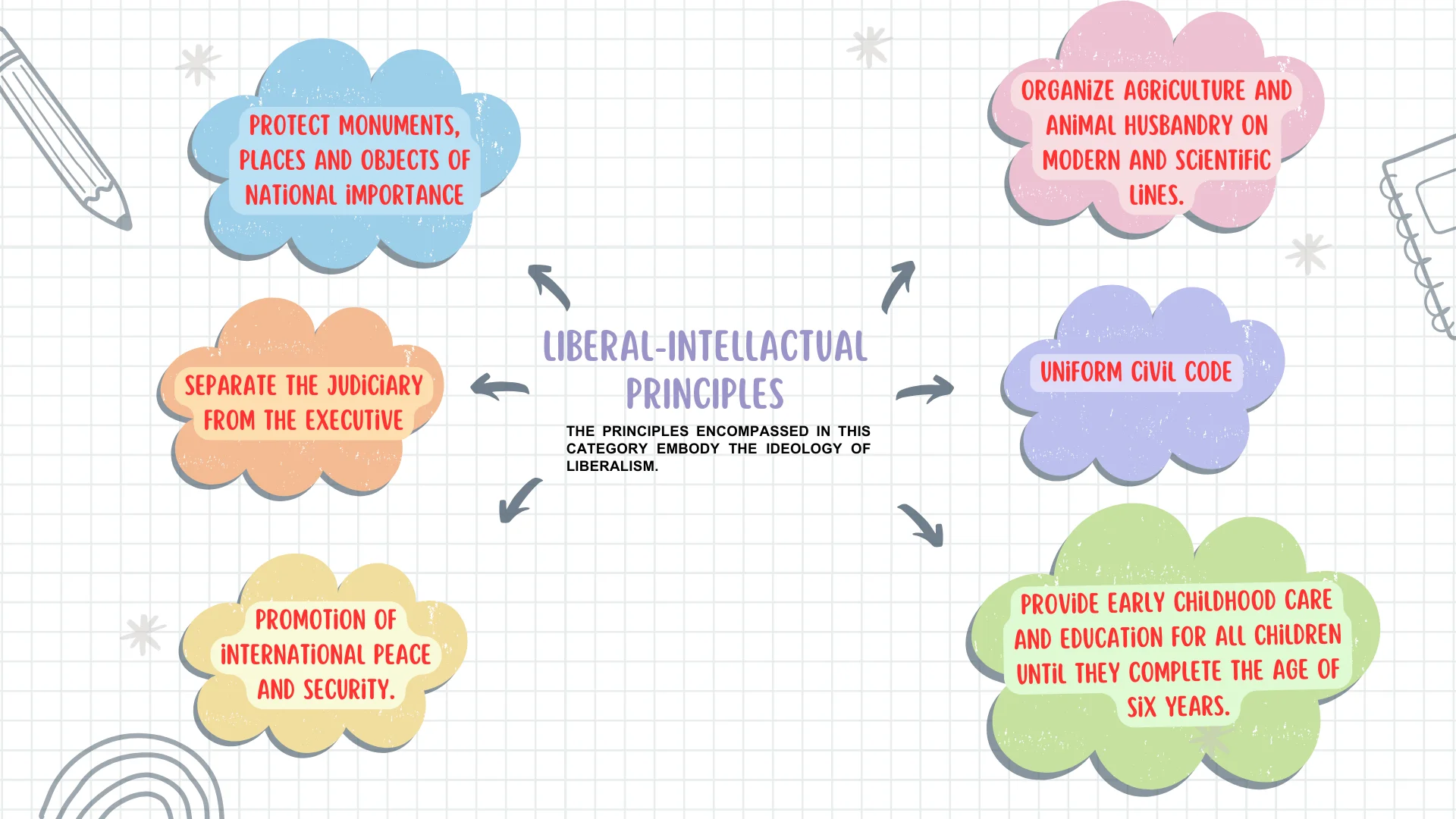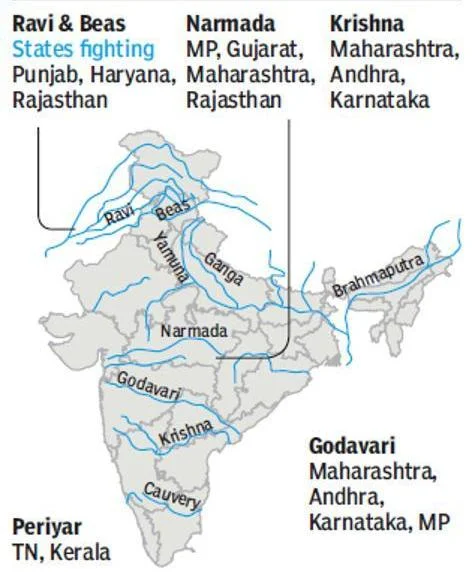Inter-State water disputes in India arise from complex interactions between State and Central authorities over shared river resources. The Constitution provides frameworks for resolving these disputes, including specific provisions for adjudication and regulatory roles for the Central Government. Despite these mechanisms, disputes remain persistent due to outdated agreements and political tensions.
Inter-State Water Disputes in India
Constitutional Provisions
- Entry 17 of the State List: It grants States the authority to legislate on matters related to water, including water supply, irrigation, canals, drainage, embankments, water storage, and hydroelectricity.
- Entry 56 of the Union List: Empowers the Central government to regulate and develop inter-State rivers and river valleys, as deemed necessary by Parliament in the public interest.
- Article 262(1): Parliament may by law provide for the adjudication of any dispute or complaint with respect to the use, distribution or control of the waters of, in any inter-State river or river valley.
- Article 262(2): Notwithstanding anything in this Constitution, Parliament may, by law, provide that neither the Supreme Court nor any other court shall exercise jurisdiction in respect of any such dispute or complaint as is referred to in clause (1)
Enroll now for UPSC Online Course
Laws Passed by the Parliament
River Board Act, 1956: Establishment of River Boards for Intergovernmental Consultation
- Lack of River Basin Formation: Although enacted in 1956, the Rivers Act has not led to the formation of any river basins under its provisions.
- Centre’s Authority to Establish River Boards: The Centre maintains the authority to establish River Boards through official notification, either in response to a State government’s request or independently.
- Function of River Boards: These River Boards function as advisory bodies to the governments, offering expert guidance on matters concerning river management and development.
- Composition of River Boards: Each River Board consists of a Chairman and other members appointed by the Central government, ensuring a diverse range of expertise and perspectives in the decision-making process.
- Role of River Boards: The Boards play a crucial role in promoting intergovernmental cooperation, facilitating the integrated management of river basins, and encouraging sustainable water resource utilization.
- Addressing Common Challenges: They address common challenges faced by States sharing a river system, contributing to effective and collaborative governance in river-related matters.
- Inter State Water Dispute Act 1956: The Inter-State River Water Disputes Act of 1956 establishes a tribunal to adjudicate disputes or complaints relating to the use, distribution, or control of inter-State river waters.
- Composition of the Tribunal: Chairman and two other members nominated by the Chief Justice of India from among sitting judges of the Supreme Court or High Courts.
- Parliament’s Authority to Exclude Jurisdiction of Courts: Clause (2) of the Act empowers Parliament to enact legislation that excludes the jurisdiction of the Supreme Court and other courts in matters related to inter-State river water disputes, vesting the tribunal with exclusive authority to resolve such issues.
- Ensuring Specialized Adjudication: This provision ensures specialised and focused adjudication of these complex and sensitive matters.
Inter-State Water Disputes in India: A Complex Web of Factors
India’s water resources are intricately linked to its political landscape, giving rise to numerous inter-State water disputes.
- These disputes stem from a complex interplay of factors, including:
- Inter-State River Network: Over 80% of India’s rivers flow across multiple States, creating the basis for numerous water resource conflicts.
- Outdated Agreements: Many existing inter-State water agreements, dating back over a century, were formulated without considering the evolving socio-economic, political, and geographical dynamics, leading to disputes over water allocation and sharing.
- Politicisation of Water: Water has become increasingly entangled in the political arena, transforming water disputes into battlegrounds for vote-bank politics.
- Unidimensional Tribunal Composition: The tribunals tasked with resolving inter-State water disputes often lack multidisciplinary representation, relying solely on legal expertise.
- This narrow composition overlooks the technical, environmental, and social dimensions of water management.
- Inadequate Water Data: The absence of authoritative water data that is mutually acceptable to all parties hinders the process of dispute resolution, making it difficult to establish a baseline for adjudication.
- Prolonged Legal Battles: Inter-State water disputes often entangle parties in protracted legal proceedings, characterised by extreme delays and a lack of timely resolutions.
- Example: The Godavari water dispute, for instance, took over 17 years to reach a conclusion, while the Cauvery water dispute spanned over two decades.
- Opaque Institutional Framework: The institutional framework governing inter-State water disputes lacks transparency, with unclear guidelines and inadequate mechanisms for ensuring compliance with tribunal awards.
- Challenges and Solutions: These factors have collectively contributed to the persistent water disputes that plague India’s inter-State river management, hindering sustainable water resource utilisation and exacerbating conflicts between States.
- Addressing these underlying issues is crucial for achieving effective and equitable water governance across the country.
Related Cases
- The Cauvery Water Dispute: A Non-Compliance and Conflict
- Introduction of the Dispute: The Cauvery River water dispute has been a longstanding issue between the Indian States of Tamil Nadu and Karnataka.
- Intervention by Central Government: In 1970, the Tamil Nadu government requested the Central government’s intervention, leading to the establishment of the Cauvery Water Disputes Tribunal in 1990 following Supreme Court directives.
- Interim Order by the Tribunal: In 1991, the tribunal issued an interim order instructing Karnataka to release water to Tamil Nadu.
- Karnataka’s Non-Compliance: Despite this, Karnataka refused to comply, escalating tensions between the two States.
- Final Verdict by the Tribunal: After 16 years of hearings, the tribunal delivered its final verdict in 2007, allocating 419 tmcft of water to Tamil Nadu and 270 tmcft to Karnataka.
- Supreme Court Charges Karnataka with Contempt: However, Karnataka persisted in resisting water release, resulting in the Supreme Court charging the State with contempt of court in 2013.
- Tamil Nadu Petitions Supreme Court: In 2016, Tamil Nadu petitioned the Supreme Court to enforce the tribunal’s guidelines and ensure water release from Karnataka.
- Protests in Karnataka: This order led to protests in Karnataka, with concerns raised about their own water scarcity.
- The Sutlej-Yamuna Link Canal
- Introduction of the SYL Canal Project: The Sutlej-Yamuna Link (SYL) canal project, aimed at diverting water from the Sutlej River to Haryana, has been embroiled in a long and contentious dispute between the States of Punjab and Haryana.
- Historical Context: Following the bifurcation of Haryana from Punjab in 1966, Punjab initially resisted sharing water with Haryana, citing the riparian principle, which asserts that the water of a river belongs to the States or countries through which it flows.
- Project Commencement: However, in 1981, the two States reached a mutual agreement on water reallocation, and construction of the SYL canal began in 1982.
- Project Commencement: However, the project faced strong opposition in Punjab, leading to agitations and the eventual halt of construction work.
- In response, Haryana moved the Supreme Court to compel Punjab to complete the canal.
- Punjab’s Legislative Action: In a significant turn of events, the Punjab Assembly passed the Punjab Termination of Agreements Act in 2004, effectively terminating its water-sharing agreements with Haryana and jeopardising the SYL project.
- Supreme Court’s Intervention: This action prompted the Supreme Court to declare the act constitutionally invalid, ruling that Punjab had reneged on its commitment to share water resources.
- Supreme Court’s Directive for Negotiations: In 2020, the Supreme Court directed the Chief Ministers of Punjab and Haryana to engage in negotiations at the highest political level, mediated by the Central government, to resolve the SYL canal issue once and for all.
- Current Status and Future Outlook: The outcome of these negotiations remains to be seen, but the SYL canal dispute continues to cast a shadow over inter-State water management in India.
- The Krishna Water Dispute
- Introduction of the Krishna Water Dispute: The Krishna Water Dispute, a long-standing issue over the allocation of Krishna River water among the States of Andhra Pradesh, Telangana, Karnataka, and Maharashtra, took a new turn following the bifurcation of Andhra Pradesh in 2014.
- Andhra Pradesh’s Request Post-Bifurcation: Andhra Pradesh, now a smaller State, sought to include Telangana as a separate party in the Krishna Water Disputes Tribunal (KWDT) and to revise the water allocation among the four States instead of the existing three-State arrangement.
- Legal Basis for the Request: This request was based on Section 89 of The Andhra Pradesh State Reorganisation Act, 2014.
- Opposition from Karnataka and Maharashtra: However, Karnataka and Maharashtra, the other riparian States, opposed this proposal, arguing that Telangana’s share should be carved out of Andhra Pradesh’s existing allocation, as Telangana was part of Andhra Pradesh when the initial allocation was determined by the KWDT.
- Complexities of Water Resource Management: This dispute highlights the complexities of inter-State water resource management and the challenges of adjusting water allocations when State boundaries change.
- Future Challenges and Solutions: Finding a solution that is fair to all parties and ensures sustainable water management for the Krishna River basin remains a critical task for the Indian government.

Enroll now for UPSC Online Course
| Must Read | |
| Current Affairs | Editorial Analysis |
| Upsc Notes | Upsc Blogs |
| NCERT Notes | Free Main Answer Writing |
Conclusion
Addressing inter-State water disputes requires updating legal frameworks and improving cooperative measures between States.
- Effective dispute resolution hinges on transparent processes and inclusive tribunals.
- Ensuring fair water distribution and managing resources sustainably are crucial for reducing conflicts and promoting harmony between States.
Sign up for the PWOnlyIAS Online Course by Physics Wallah and start your journey to IAS success today!
| Related Articles | |
| High Courts in India | Inter-State Water Disputes Resolution |
| Water Management: How Can India Balance Its Water Demand and Supply? | Supreme Court of India |

 GS Foundation
GS Foundation Optional Course
Optional Course Combo Courses
Combo Courses Degree Program
Degree Program












